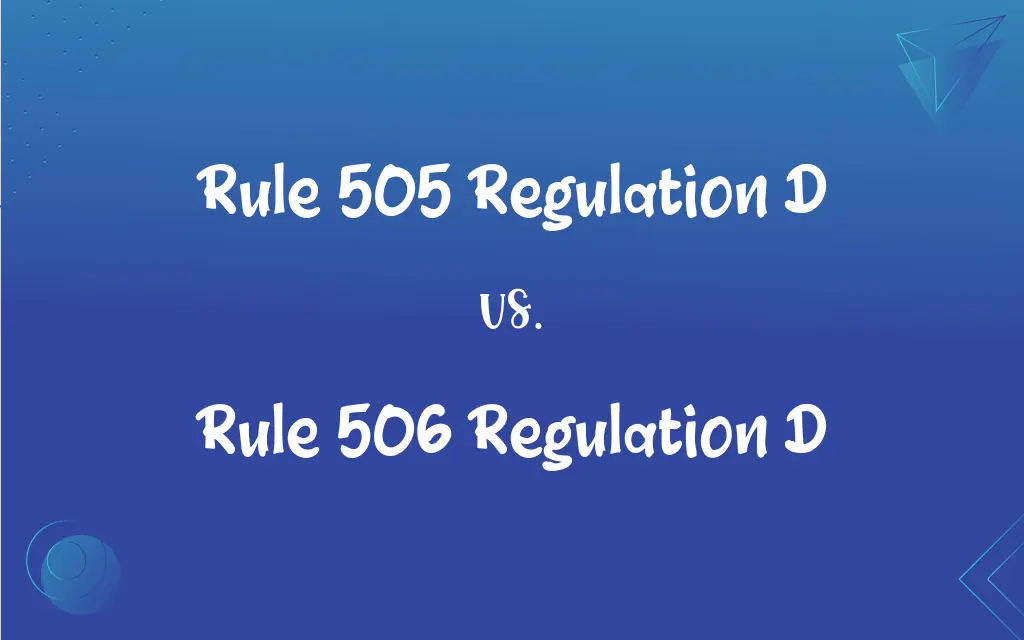Rule 505 Regulation D vs. Rule 506 Regulation D: What's the Difference?
Edited by Aimie Carlson || By Janet White || Published on July 23, 2024
Rule 505 Regulation D allows offerings up to $5 million with limited disclosure, while Rule 506 Regulation D permits unlimited capital raising but with restrictions on general solicitation and investor qualifications.

Key Differences
Rule 505 Regulation D offers a way for companies to raise capital up to $5 million in a 12-month period from accredited and non-accredited investors with limited disclosure requirements. Rule 506 Regulation D, in contrast, allows companies to raise an unlimited amount of capital but primarily from accredited investors, with stringent conditions on the solicitation of potential investors and disclosure obligations.
Under Rule 505 Regulation D, companies can sell securities to an unlimited number of accredited investors and up to 35 non-accredited but sophisticated investors, requiring them to provide financial statements but not necessarily audited ones. Rule 506 Regulation D, however, does not limit the number of accredited investors but restricts the involvement of non-accredited investors unless the company meets extensive disclosure requirements, including providing audited financial statements.
Rule 505 Regulation D does not prohibit general solicitation or advertising for the securities offering, it does impose restrictions on resale, leading to a less fluid secondary market. Conversely, Rule 506 Regulation D, particularly under its 506(b) provision, prohibits general solicitation and advertising, but Rule 506(c) allows for these activities if all investors are verified as accredited.
The adherence to Rule 505 Regulation D is generally perceived as less cumbersome for smaller companies seeking capital infusion without the need for extensive disclosure, making it a viable option for startups and SMEs. On the other hand, Rule 506 Regulation D is more suitable for larger enterprises or those seeking a substantial capital influx, willing to comply with stricter investor verification processes and disclosure standards.
Both Rule 505 Regulation D and Rule 506 Regulation D serve as exemptions under the Securities Act of 1933, aiming to simplify the capital-raising process for companies while providing a framework to protect investors. However, the choice between the two rules largely depends on the company's financial targets, the investor base, and the readiness to meet disclosure and compliance standards.
ADVERTISEMENT
Comparison Chart
Capital Raising Limit
Up to $5 million in a 12-month period
Unlimited capital raising
Investor Qualifications
Accredited and up to 35 non-accredited investors
Primarily accredited; non-accredited under conditions
Disclosure Requirements
Limited; financial statements required
More extensive; audited financials for non-accredited
General Solicitation
Not prohibited but restricted
Prohibited under 506(b); allowed under 506(c) with conditions
Secondary Market Liquidity
Restrictions on resale; less liquid secondary market
Fewer restrictions; potentially more liquid secondary market
ADVERTISEMENT
Rule 505 Regulation D and Rule 506 Regulation D Definitions
Rule 505 Regulation D
Rule 505 Regulation D permits limited fundraising with reduced disclosure requirements.
Appreciating the reduced compliance burden, the company opted for Rule 505 Regulation D for their initial round.
Rule 506 Regulation D
Rule 506 Regulation D facilitates unlimited capital raising predominantly from accredited investors with stringent disclosure norms.
To fund its major expansion, the corporation utilized Rule 506 Regulation D, targeting affluent, accredited investors.
Rule 505 Regulation D
Rule 505 Regulation D is a capital raising exemption allowing up to $5 million from both accredited and certain non-accredited investors.
The startup chose Rule 505 Regulation D to secure funding from a diverse investor group within the $5 million limit.
Rule 506 Regulation D
Rule 506 Regulation D mandates extensive disclosure, including audited financials, if non-accredited investors are involved.
The company, offering securities under Rule 506 Regulation D, prepared exhaustive disclosure documents to include a few non-accredited investors.
Rule 505 Regulation D
Rule 505 Regulation D requires provision of financial statements, not necessarily audited, to investors.
Leveraging Rule 505 Regulation D, the company prepared financial statements without undergoing a costly audit.
Rule 506 Regulation D
Rule 506 Regulation D does not limit the number of accredited investors and provides a more fluid secondary market.
Opting for Rule 506 Regulation D, the company attracted numerous accredited investors, enhancing the liquidity of its secondary market.
Rule 505 Regulation D
Rule 505 Regulation D allows offers to an unlimited number of accredited investors and up to 35 non-accredited investors.
To accommodate its broad investor base, the firm utilized Rule 505 Regulation D's provision for 35 non-accredited investors.
Rule 506 Regulation D
Rule 506 Regulation D, while offering a pathway for substantial capital raising, demands rigorous compliance with SEC regulations.
The company's legal team meticulously navigated the complexities of Rule 506 Regulation D to ensure a successful fundraising campaign.
Rule 505 Regulation D
Rule 505 Regulation D does not completely restrict general solicitation but imposes resale limitations.
The company marketed its offering under Rule 505 Regulation D, mindful of the limitations on resale to maintain compliance.
Rule 506 Regulation D
Rule 506 Regulation D prohibits general solicitation under its 506(b) provision but allows it under 506(c) with accredited investor verification.
The firm engaged in widespread advertising of its offering after ensuring compliance with Rule 506(c) Regulation D's verification requirements.
FAQs
Are non-accredited investors allowed in Rule 506 Regulation D offerings?
Yes, but only under 506(b) with stringent disclosure requirements, while 506(c) offerings are limited to verified accredited investors.
What are the capital raising limits for Rule 506 Regulation D?
Rule 506 Regulation D does not impose a limit on the amount of capital that can be raised.
Can non-accredited investors participate in a Rule 505 Regulation D offering?
Yes, up to 35 non-accredited but sophisticated investors can participate in a Rule 505 Regulation D offering.
Can companies use general solicitation in Rule 506 Regulation D offerings?
General solicitation is prohibited under Rule 506(b) but allowed under Rule 506(c) if all investors are verified as accredited.
Which companies are more likely to use Rule 506 Regulation D?
Larger companies or those seeking substantial capital typically use Rule 506 Regulation D due to its allowance for unlimited fundraising and a larger investor base.
What are the disclosure requirements for Rule 505 Regulation D?
Companies must provide financial statements, which do not necessarily need to be audited, under Rule 505 Regulation D.
What is the maximum amount that can be raised under Rule 505 Regulation D?
Rule 505 Regulation D allows companies to raise up to $5 million in a 12-month period.
Is general solicitation allowed under Rule 505 Regulation D?
General solicitation is not expressly prohibited under Rule 505 Regulation D but is subject to certain limitations.
What companies typically use Rule 505 Regulation D?
Rule 505 Regulation D is often used by startups and SMEs for its relatively straightforward compliance and fundraising up to $5 million.
What disclosure is required under Rule 506 Regulation D?
Rule 506 Regulation D requires extensive disclosure, including audited financial statements if non-accredited investors are involved.
Are there resale restrictions for securities acquired under Rule 505 Regulation D?
Yes, securities acquired under Rule 505 Regulation D have resale restrictions, impacting the liquidity of the secondary market.
What are the consequences of not verifying accredited investors under Rule 506(c) Regulation D?
Failing to adequately verify accredited investors under Rule 506(c) can result in the loss of the exemption and potential SEC enforcement action.
Can a company switch from Rule 505 Regulation D to Rule 506 Regulation D?
Companies can switch, but they must comply with the specific requirements and limitations of the rule they are transitioning to.
Can Rule 505 Regulation D or Rule 506 Regulation D offerings be publicly advertised?
Rule 505 Regulation D offerings may have limited advertising, while Rule 506(c) allows for general solicitation with accredited investor verification, but Rule 506(b) does not allow public advertising.
Is there a limit on the number of investors for Rule 506 Regulation D offerings?
No, there is no limit on the number of accredited investors in Rule 506 Regulation D offerings.
Is it necessary to file any forms with the SEC for Rule 505 or Rule 506 Regulation D offerings?
Yes, companies must file a Form D with the SEC after they first sell securities under both Rule 505 and Rule 506 Regulation D offerings.
How many accredited investors can participate in a Rule 505 Regulation D offering?
There is no limit on the number of accredited investors in a Rule 505 Regulation D offering.
What happens if a company exceeds the $5 million limit under Rule 505 Regulation D?
Exceeding the $5 million limit can lead to the loss of the exemption, and the company may face regulatory action.
What is the duration for filing Form D for both rules?
Form D should be filed within 15 days after the first sale of securities under both Rule 505 and Rule 506 Regulation D.
What about the liquidity of securities under Rule 506 Regulation D?
Securities acquired under Rule 506 Regulation D typically face fewer resale restrictions, potentially enhancing secondary market liquidity.
About Author
Written by
Janet WhiteJanet White has been an esteemed writer and blogger for Difference Wiki. Holding a Master's degree in Science and Medical Journalism from the prestigious Boston University, she has consistently demonstrated her expertise and passion for her field. When she's not immersed in her work, Janet relishes her time exercising, delving into a good book, and cherishing moments with friends and family.
Edited by
Aimie CarlsonAimie Carlson, holding a master's degree in English literature, is a fervent English language enthusiast. She lends her writing talents to Difference Wiki, a prominent website that specializes in comparisons, offering readers insightful analyses that both captivate and inform.






































































